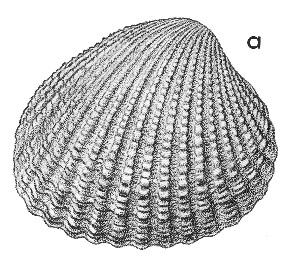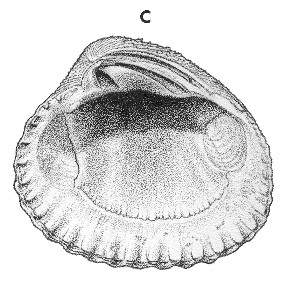
Revised descriptions of New Zealand Cenozoic Mollusca from Beu and Maxwell (1990)

 | Revised descriptions of New Zealand Cenozoic Mollusca from Beu and Maxwell (1990) | 
|
  (Pl. 32a): GS4124, R22/f6543, Wilkies Shellbed, Wilkies Bluff, mouth of Waitotara River, west of Wanganui, Mangapanian (GNS) |
  (Pl. 32c): GS4124, R22/f6543, Wilkies Shellbed, Wilkies Bluff, mouth of Waitotara River, west of Wanganui, Mangapanian (GNS) |
Beu & Maxwell (1990): Chapter 14; p. 281; pl. 32 a,c.
Synonymy: Cardita purpurata Deshayes 1854a, p. 100; ?C. difficilis Deshayes 1854a, p. 103; Venericardia australis of Gray 1843, p. 256, and of Suter 1913c, p. 905, not of Lamarck, 1818; Cardita tridentata "Say" Reeve 1843, pl. 5, fig. 22 (not Venericardia tridentata Say, 1826)
Type species of Purpurocardia Maxwell, 1969
Classification: Carditidae: Venericardiinae
Description: Moderately large for family (28-60 mm long), very thick and solid, oval to subrectangular, with prominent umbones at anterior quarter of length. Lunule very short, convex, almost vertical, very deeply impressed. External sculpture of 23-26 prominent, wide, rounded radial costae, narrower on the postero-dorsal slope than elsewhere, crossed by low, narrow, rounded, closely spaced commarginal ridges on radial costal surfaces only. Inner ventral margin coarsely crenulate. Hinge wide and thick; in the right valve 1 prominent, extremely wide, bevelled cardinal tooth, with a deep socket on each side; in the left valve, 2 very prominent, relatively narrow cardinal teeth separated by a very wide, deep socket (hinges are transposed in a specimen in GS4124, Wilkies Bluff, Wanganui, Mangapanian). Anterior adductor scar significantly larger than posterior, deeply impressed; pallial line without sinus.
Comparison: Purpurocardia purpurata is highly variable and difficult to understand taxonomically; it appears likely that P. difficilis (Deshayes) is a distinct deep-water species in the modern fauna, and the status is unclear of the several dubiously distinct, relatively young fossils similar to P. purpurata (P. beata, Opoitian; P. lilliei, Waipipian; P. southlandica, Kapitean; P. titirangiensis, Nukumaruan). P. purpurata lives today in shallow-water, near-shore environments, mostly in high-energy sites such as tidal channels, which explains its abundance in shallow-water shellbeds in the Wanganui Series.
Distribution: Opoitian?; Waipipian-Recent. Recent, New Zealand (type); abundant in shellbeds and other near-shore, soft-bottom Pliocene and Pleistocene assemblages throughout New Zealand.
Cite this publication as: "A.G. Beu and J.I. Raine (2009). Revised
descriptions of New Zealand Cenozoic Mollusca from Beu and Maxwell (1990). GNS
Science miscellaneous series no. 27."
© GNS Science, 2009
ISBN
978-0-478-19705-1
ISSN 1177-2441
(Included with a PDF facsimile file
copy of New Zealand Geological Survey Paleontological Bulletin 58 in CD version
from: Publications Officer, GNS Science, P.O. Box 30368 Lower Hutt, New
Zealand)